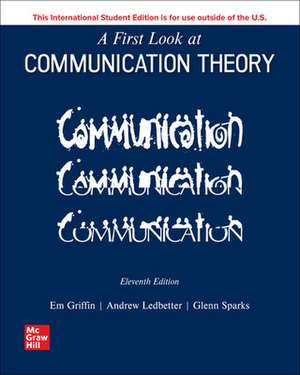A First Look at Communication Theory ISE
Autor Em Griffin, Andrew Ledbetter, Glenn Sparksen Limba Engleză Paperback – 20 mai 2022
The discrete presentation of the theories ensures a well-rounded understanding of each while promoting integrative thinking and facilitating the ability of instructors to skip or rearrange their presentation. The broad selection of theories-from the classics to the cutting edge-ensures that students have a solid foundation with which to begin understanding the relationships between theories.
Preț: 428.74 lei
Preț vechi: 466.02 lei
-8% Nou
Puncte Express: 643
Preț estimativ în valută:
82.05€ • 85.55$ • 68.19£
82.05€ • 85.55$ • 68.19£
Carte disponibilă
Livrare economică 27 februarie-13 martie
Livrare express 13-19 februarie pentru 43.86 lei
Preluare comenzi: 021 569.72.76
Specificații
ISBN-13: 9781265209247
ISBN-10: 1265209243
Pagini: 578
Dimensiuni: 208 x 262 x 20 mm
Greutate: 0.82 kg
Ediția:11
Editura: McGraw Hill Education
Colecția McGraw-Hill
Locul publicării:United States
ISBN-10: 1265209243
Pagini: 578
Dimensiuni: 208 x 262 x 20 mm
Greutate: 0.82 kg
Ediția:11
Editura: McGraw Hill Education
Colecția McGraw-Hill
Locul publicării:United States
Cuprins
Division One: Overview
Ch. 1: Launching Your Study
Ch. 2: Talk About Theory
Ch. 3: Weighing the Words
Ch. 4: Mapping the Territory
Division Two: Interpersonal Communication
Interpersonal Messages
Ch. 5: Symbolic Interactionism
Ch. 6: Expectancy Violations Theory
Ch. 7: Family Communication Patterns Theory
Relationship Development
Ch. 8: Social Penetration Theory
Ch. 9: Uncertainty Reduction Theory
Ch. 10: Social Information Processing Theory
Relationship Maintenance
Ch. 11: Relational Dialectics Theory
Ch. 12: Communication Privacy Management Theory
Ch. 13: Media Multiplexity Theory
Division Three: Social Influence Persuasion
Ch. 14: Social Judgment Theory
Ch. 15: Elaboration Likelihood Model
Ch. 16: Cognitive Dissonance Theory
Public Rhetoric
Ch. 17: The Rhetoric
Ch. 18: Dramatism
Ch. 19: Narrative Paradigm
Division Four: Group and Organizational Communication
Group Communication
Ch. 20: Functional Perspective on Group Decision-Making
Ch. 21: Symbolic Convergence Theory
Organizational Communication
Ch. 22: Cultural Approach to Organizations
Ch. 23: Communicative Constitution of Organizations
Ch. 24: Critical Theory of Communication in Organizations
Division Five: Cultural Context
Intercultural Communication
Ch. 25: Communication Accommodation Theory
Ch. 26: Face-Negotiation Theory
Ch. 27: Co-Cultural Theory
Ch. 28: Afrocentricity
Gender and Communication
Ch. 29: Feminist Standpoint Theory
Ch. 30: Muted Group Theory
Division Six: Mass Communication
Media and Culture
Ch. 31: Media Ecology
Ch. 32: Context Collapse
Ch. 33: Semiotics
Ch. 34: Cultural Studies
Media Effects
Ch. 35: Uses and Gratifications
Ch. 36: Cultivation Theory
Ch. 37: Agenda-Setting Theory
Division Seven: Integration
Ch. 38: Common Threads in Comm Theories
Ch. 1: Launching Your Study
Ch. 2: Talk About Theory
Ch. 3: Weighing the Words
Ch. 4: Mapping the Territory
Division Two: Interpersonal Communication
Interpersonal Messages
Ch. 5: Symbolic Interactionism
Ch. 6: Expectancy Violations Theory
Ch. 7: Family Communication Patterns Theory
Relationship Development
Ch. 8: Social Penetration Theory
Ch. 9: Uncertainty Reduction Theory
Ch. 10: Social Information Processing Theory
Relationship Maintenance
Ch. 11: Relational Dialectics Theory
Ch. 12: Communication Privacy Management Theory
Ch. 13: Media Multiplexity Theory
Division Three: Social Influence Persuasion
Ch. 14: Social Judgment Theory
Ch. 15: Elaboration Likelihood Model
Ch. 16: Cognitive Dissonance Theory
Public Rhetoric
Ch. 17: The Rhetoric
Ch. 18: Dramatism
Ch. 19: Narrative Paradigm
Division Four: Group and Organizational Communication
Group Communication
Ch. 20: Functional Perspective on Group Decision-Making
Ch. 21: Symbolic Convergence Theory
Organizational Communication
Ch. 22: Cultural Approach to Organizations
Ch. 23: Communicative Constitution of Organizations
Ch. 24: Critical Theory of Communication in Organizations
Division Five: Cultural Context
Intercultural Communication
Ch. 25: Communication Accommodation Theory
Ch. 26: Face-Negotiation Theory
Ch. 27: Co-Cultural Theory
Ch. 28: Afrocentricity
Gender and Communication
Ch. 29: Feminist Standpoint Theory
Ch. 30: Muted Group Theory
Division Six: Mass Communication
Media and Culture
Ch. 31: Media Ecology
Ch. 32: Context Collapse
Ch. 33: Semiotics
Ch. 34: Cultural Studies
Media Effects
Ch. 35: Uses and Gratifications
Ch. 36: Cultivation Theory
Ch. 37: Agenda-Setting Theory
Division Seven: Integration
Ch. 38: Common Threads in Comm Theories
